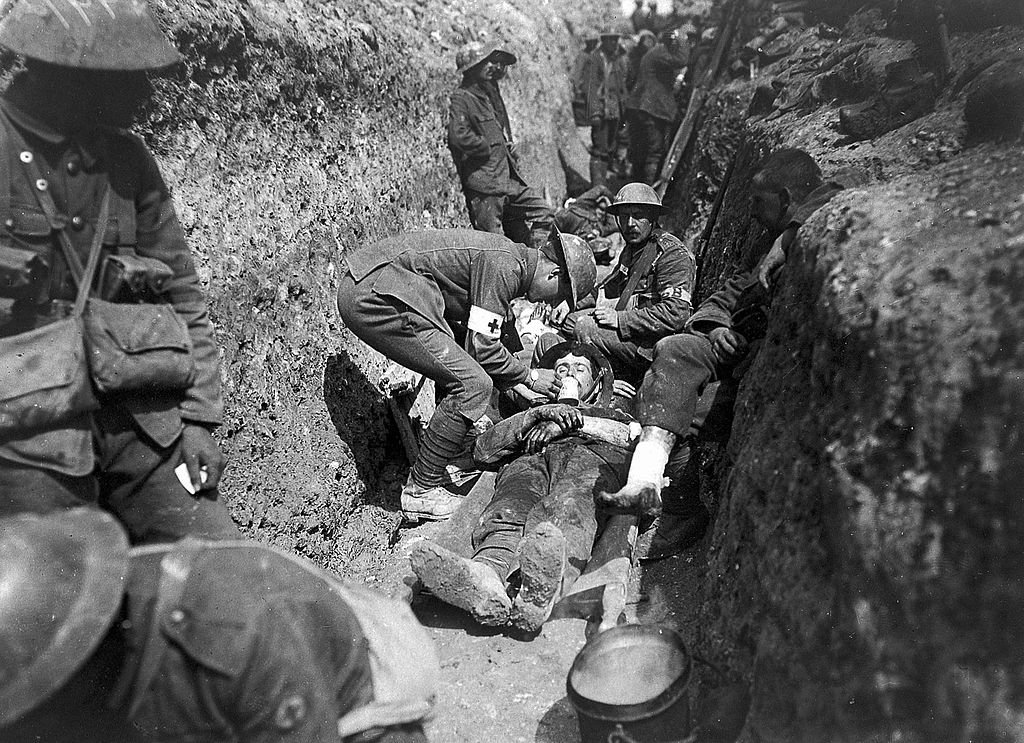4 July 2022
Unsurprisingly, the names of these two afflictions come out of World War I, which was characterized on the western front by trench warfare. While the names date to the war, the afflictions themselves were known to medicine long before then.
Trench foot, also commonly known today as immersion foot, occurs when the feet remain wet over a long period. It was first described during another war, when Dr. Dominique Jean Larrey, a French army surgeon, described the condition that was occurring among Napoleon’s soldiers during their retreat from Moscow in 1812. The condition frequently occurs among soldiers, although it is by no means limited to them; anyone in cold, wet conditions for an extended period without dry footwear can suffer from it.
The earliest appearance of trench foot in print that I’m aware of is from the British medical journal The Lancet of 30 January 1915:
The so-called cases of trench pain or trench feet usually have no tissue destruction, no blebs, and not even any discolouration of the skin; they would appear to be due to acute neuritis of the feet excited by cold and exposure.
The use of “so-called” here indicates that the term was already in use by British soldiers, and perhaps the term can be antedated by a few months in diaries and letters.
While it has a similar name, trench mouth has a very different medical etiology. Acute necrotizing ulcerative gingivitis is caused by a bacterial infection. It’s easily prevented through proper oral care, but as that is often not available on the battlefield, it was associated with soldiers. It’s painful but not serious if treated, and it can be easily treated today with professional dental cleaning and antibiotics.
The name trench mouth is first recorded in the United States prior to that country’s entry into the war. Descriptions of the disease afflicting troops in Europe appear in an article syndicated by the United Press Service on 9 July 1916. Here is an extract from the version that appeared in the Kalamazoo Gazette-Telegraph (The Oxford English Dictionary cites the same UP report but from a different paper):
The first symptom is the growth of a white lining in the mouth and throat. This resembles diphtheria. The inside of the mouth becomes painfully sensitive and at the climax of the attack the entire mouth is padded with cotton. After the climax, recovery is rapid.
“Trench mouth” is the popular name of the ailment but the British Tommies call it “foot and mouth disease,” or sometimes, “lump jaw.”
But again, the disease itself had been characterized earlier by a French doctor, Jean Hyacinthe Vincent (1862–1950), and alternative names for the disease use his name. Vincent’s angina and angina of Vincent are recorded in the Lancet of 3 May 1902:
Dr. STCLAIR [sic] THOMSON exhibited a case of Chancriform Ulcer of the Tonsil or “Vincent’s Angina.” The patient, a boy, aged 12 years, had only been complaining of a little sore-throat for four days. The right tonsil was seen to be occupied by an oblong greyish slough made up of a pulpy or chalky membrane which was easily detached. The case was shown as illustrating an uncommon form of membranous ulceration of the tonsil which had been described on the continent under various names, such as “diphtheroid angina,” “membranous amygdalitis,” and “ulcerating lacunar tonsillitis.” The name “angina of Vincent” was given to it in consequence of the discovery by Vincent in the membrane of a spindle-shaped bacillus of 4 μ in length and 1 μ in width. He had previously discovered the same bacillus in the dirt of hospitals.
Sources:
Bush, Jeffrey S., Trevor Lofgren, and Simon Watson. “Trench Foot.” National Library of Medicine, 15 May 2022.
“Clinical Society of London.” The Lancet, 159.4105, 3 May 1902, 1251. Elsevier: ScienceDirect Journals Complete.
Oxford English Dictionary, third edition, June 2014, s.v. trench, n.
“Strange Disease Attacks Soldiers.” Kalamazoo Gazette-Telegraph (Michigan), 8 July 1916, 4. America’s Historical Newspapers.
Turrell, W.J. “Electrotherapy at a Base Hospital.” The Lancet, 185.4770, 30 January 1915, 230. Elsevier: ScienceDirect Journals Complete.
Photo credit: unknown photographer, 1914–18. Public domain image. Wellcome Collection.

